Minamata is often described as a condensed version or “miniature portrait” (shukuzu) of modern Japan. Like “Việt Nam” for Americans, “Minamata” for Japanese is much more than a place name. It signifies an era of conflicts, tragedies, and transformations whose repercussions have yet to fade away. Just as Việt Nam can serve as a lens on important parts of twentieth-century United States history, Minamata is a window on much of modern Japanese history. A course or unit centered on Minamata would illuminate many of the major themes introduced in a survey designed to “cover everything,” and would do so in a way students would find engaging and memorable.
To anyone familiar with Minamata’s geography but not its history, the importance of this remote city on Japan’s southernmost main island of Kyushu would not be obvious. Far from national and regional centers of power, never a major node for land or seaborne transportation, and too hilly to produce much of an agricultural surplus, it might be assumed to be nothing more than a small fishing port. Until the early twentieth century such an assumption would have been correct. But the environmental disaster experienced by Minamata in the twentieth century places it at the very center of much of Japan’s modern experience.
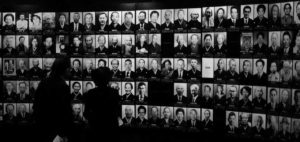
What is Minimata?
The Minamata mercury poisoning was the biggest of the “Big Four” pollution cases in the news and the courts in the late 1960s and early 1970s. The others were cadmium poisoning in Toyama, air pollution in Yokkaichi, and a “second Minamata disease” in Niigata, where the Shōwa Denkō factory dumped mercury into the Agano River. These incidents symbolized the costs of high growth and the rise of the citizens’ movement. Minamata disease was caused by mercury used as a catalyst in the Chisso Corporation’s chemical factory and discharged into the sea from 1932 to 1968. Absorbed and concentrated in the food chain and consumed by humans in fish and shellfish, it destroyed nerve and brain cells, causing loss of sensory abilities, a narrowed field of vision, tremors, and sometimes death. None of this was understood in the spring of 1956 when a new “strange disease” was officially reported. By December, there were fifty-two known patients, seventeen of whom had died. The Minamata story then became the story of efforts by doctors, scientists, government, and the company to determine (or hide) the cause, and of efforts by victims to have the pollution stopped, to be compensated for their suffering and losses, and to have their status as victims and the responsibility of the company and the government recognized.
The first round of responses ended in 1959 with an agreement under which Chisso gave patients small “sympathy payments” without accepting responsibility, even though it knew from secret experiments that its waste caused the disease. During this period patients protested and demanded compensation while struggling not only with their disease but also with ostracism in a company town. The research group appointed by the Ministry of Health and Welfare was dissolved before it presented its report concluding that organic mercury, which could only be from the Chisso factory, caused the disease. But with the sympathy payments and new waste treatment facilities (which did not remove mercury), it was wrongly assumed, for the first time but not the last, that the Minamata disease problem had been solved.

A second round of responses began in 1969. High economic growth had brought dramatic changes that made the nation more able and willing to pay some of the costs of that growth. These changes also gave Minamata disease victims opportunities to attract nationwide support. When some patients sued Chisso in 1968, Minamata became the last of the Big Four to go to court.
A nationwide network of support groups helped the victims. Protests regularly appeared on the television news. Patients and supporters bought shares in Chisso so they could attend shareholders’ meetings and confront executives directly; others forced “direct negotiations” at Chisso’s Tokyo headquarters. The patients who sued won their case in 1973, and an agreement awarded all certified patients reasonable compensation and confirmed Chisso’s responsibility. Since Chisso had stopped using mercury and all certified patients would receive reasonable compensation, it was said that this time the Minamata issue had finally been fully resolved.
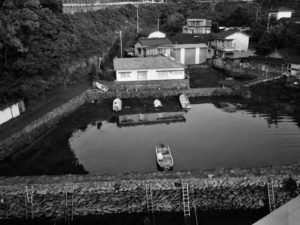
1956. ©Timothy S. george
Of course it had not. Compensation and medical care were provided only to officially certified patients—many who had applied for certification had been rejected—and there had been no legal determination regarding government responsibility. Lawsuits continued over these issues, but in 1995 nearly all were dropped in return for a government plan providing one-time payments to patients deemed “affected” by the disease but not certified. Well over 10,000 victims were compensated under this plan, in addition to the 2,271 certified patients (as of July 31, 2010).
One group of about fifty patients refused to drop their lawsuit and accept this compensation. The Supreme Court ruled in their favor in October 2004, finding the national and prefectural governments guilty of allowing the disease to spread after its discovery and ordering the government to relax its certification criteria. To date it has refused to do so, but thousands more people applied for certification or filed new lawsuits. A new agreement reached in March 2010 will compensate as many as 35,000 more uncertified patients, but they will receive far less than those who are certified, and some lawsuits over certification and responsibility continue. The Minamata issue remains, like the legacies of the Asia-Pacific War, central to Japan’s twentieth-century experience, and an issue that cannot be made to go away.
Minamata and Japan’s Environmental History
As suggested earlier, Minamata is a bridge to important themes in modern Japanese history. It is the obvious starting point for a broader look at Japan’s environmental history. One might move from Minamata to the other three of the Big Four officially recognized pollution diseases, particularly Niigata Minamata disease. In Niigata, mercury poisoning was reported along the Agano River downstream of Shōwa Denkō’s factory in Kanose in 1965, but here the situation and response differed in significant ways from Minamata. Scientists, doctors, journalists, and citizen activists reacted much more quickly than they had to the discovery of the Minamata outbreak nine years earlier. Since this mercury was discharged into a river, most of the victims lived downstream rather than in Kanose and were not subjected to the same economic and social restraints against suing the company as the residents of Minamata. Victims sued Shōwa Denkō in 1967. Ties established between Minamata and Niigata patients’ groups spurred victims in Minamata to sue Chisso in 1969.
The earlier environmental history of Minamata offers an illustration of how Japan in the Meiji period (1868–1912) began to dramatically transform its environment in new ways, on a new scale, and with new technologies. A new dam in the mountains above Minamata generated electricity that was first used to provide power and light to the nearby gold mines. Minamata had lost jobs when salt-making was shut down by the government and laborers were no longer needed to transport coal by cart to the gold mines that now had a more convenient energy source. In 1908 Noguchi Shitagau was persuaded to build his new chemical factory in Minamata, which offered cheap labor, land, and electric power. The factory used limestone from the hills surrounding the Shiranui Sea, along with air and electricity, to produce nitrogen fertilizer and acetylene for lamps.
Tales of Minamata often end in 1973 with the historic court victory. But events since then—aside from the continuing struggles over certification and government responsibility—illustrate important themes in Japan’s recent environmental history. Some patients and activists began to grow fruit, vegetables, and rice organically, not wishing to poison others the way that Chisso had poisoned them and their neighbors. One serious problem remaining after 1973 was the toxic sludge fouling Minamata Bay. The government created fifty-eight hectares of reclaimed land by dredging sludge from the most polluted areas, dumping it in the innermost part of the bay behind a retaining wall and covering it with a thick plastic sheet and finally with clean dirt.
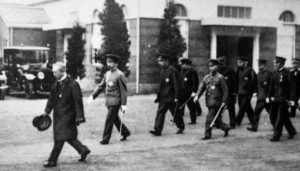
Minamata and Tokugawa Japan
Minamata also offers a case study of local government and economy before the Meiji period. The sixteenth century civil wars dislodged the Sagara family, which had controlled the area since being appointed land steward of the region by the Kamakura shogunate in 1205. In 1631, the new Tokugawa shogunate designated the Hosokawa family as daimyō, or lords, of Higo (now Kumamoto Prefecture) and the Hosokawa appointed the Fukami family to administer the Minamata area. Survey texts might lead one to assume that such powerful local families were removed from power by the new Meiji government as it built, for the first time in Japan’s history, a system of direct central control of local government. But the Fukami, like many important local families elsewhere in Meiji Japan, remained powerful, serving as mayors as late as 1910, two years before the end of Meiji and two years after the factory arrived to become Minamata’s third local “feudal lord” (tonosama), as it was often called.
Most residents of this small coastal village farmed, fished, or did both. Society in the hamlets making up the village became more stratified during the Tokugawa period, as was the case elsewhere. In the fishing hamlets, amimoto (“net owners”) had amiko (“net children”) working for them. In farming hamlets landlords had nago (tenant workers, often hereditary, who were virtually serfs).
Minamata was on the Satsuma Kaidō, the highway on which the daimyō of Satsuma (the domain to the south; now Kagoshima Prefecture) traveled to and from the Tokugawa capital of Edo under the alternate attendance system requiring all daimyō to spend half their time in Edo. There were a few inns, some porters, and others who made their living from travelers. More people worked the saltpans set up in the seventeenth century by the Hosokawa as a domain monopoly. The salt was probably transported mostly by sea, with goods such as pottery, noodles, and tiles being brought to Minamata on the return trips. While Minamata was less developed economically than many other parts of Japan, even here by the nineteenth century few people could be called peasants, if “peasant” describes mostly self-sufficient agriculturalists who have little connection to markets and a cash economy.
Shōwa Corporation-State Relations
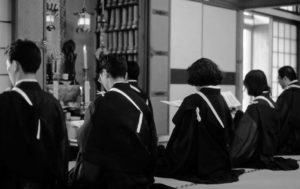
Chisso’s relationship with the state is best symbolized by the two official visits made to the Minamata factory by Hirohito, the Shōwa emperor, in 1931 and 1949. An official corporate history from 1940 stressed the role the company played in the “holy war” as “our nation’s largest producer of explosives,” “not . . . as a profit-making company” (though its wartime profits were high), but as “a national policy corporation.”1
Like Japan, Chisso lost its overseas possessions in 1945, and its factories in Japan were heavily damaged by American bombing. But science and technology, particularly chemicals, were as important to Japan’s pursuit of recovery and high growth as they had been to its “holy war.” Chisso’s products were essential to the new age of plastics. Kumamoto University researchers seeking the cause of Minamata disease after its outbreak could not get samples of factory waste without permission from the Ministry of International Trade and Industry (MITI). In 1959, MITI distributed a pamphlet refuting the theory that mercury caused Minamata disease, while confidentially advising Chisso’s president that the issue was becoming a political problem. MITI’s head at the time was Ikeda Hayato, who in November 1959 warned fellow cabinet ministers not to decide that the company’s mercury caused the disease.
As prime minister in 1960, Ikeda would announce his plan to double Japan’s real income within a decade. Chisso’s chemicals were essential to that growth. It was no coincidence that the government quashed its research group’s report on the disease in 1959, and did not officially conclude that Chisso’s mercury caused Minamata disease until 1968, when the factory stopped using mercury. High growth came at a high cost.

Relations with the World
Chisso’s story and that of the disease it caused, also illustrate themes in Japan’s relations with the world in the twentieth century. Chisso’s first big growth spurt came when World War I cut off European fertilizer sales to Southeast Asia and Chisso filled the gap. The company survived the post-war slump caused by the return of foreign competition by going to Europe to purchase rights to more advanced technologies, enabling it to lower production costs drastically. By the 1930s, it was developing most of its own technology and had become one of Japan’s “new” zaibatsu (large and influential industrial and financial conglomerates). In prewar and wartime Japan, Chisso symbolized national success and advanced technology, just as Toyota, Sony, and Honda did in the postwar.
As Japan expanded overseas, Chisso followed the flag that appeared on its products as its corporate symbol. Korea offered even lower labor and land costs and more hydroelectric power potential than Minamata. Chisso built the world’s second largest dam there to supply power to its factory at Hungnam employing 45,000 workers, and the company sent its best and brightest to Korea. Before World War II ended, it had operations in China, Taiwan, and Southeast Asia. Some of the hydropower projects Chisso planned in Southeast Asia were completed after the war, partly with Japanese government financing as reparations or aid projects, by a corporation founded by former Chisso executives who had worked in Manchuria and Korea.
Responses to Minamata disease have involved a number of important global links as well. Leonard Kurland of the US National Institutes of Health (NIH) collected fish in Minamata in 1958 and found they caused symptoms of Minamata disease in cats. He wrote to Japanese newspapers in support of the Kumamoto University scientists’ belief that the disease was caused by mercury, and the NIH supported Kumamoto University studies on Minamata disease in the early 1960s when Japan’s Ministry of Health and Welfare cut off its funding.
American photojournalist W. Eugene Smith did more than anyone else to bring Minamata disease to the world’s attention. Smith virtually invented the photographic essay at Life magazine in the 1940s and 1950s. Smith and his wife Aileen moved to Minamata in 1971. Their 1972 Life photo essay, and especially the powerful photographs and essays in their 1975 book Minamata, shocked and moved the world.
In 1972, Ui Jun, Japan’s leading environmental scientist-activist and the man who had brought the Minamata and Niigata patients together, brought Minamata disease patients to the first United Nations global environmental conference in Stockholm. One of them, Hamamoto Tsuginori, later helped establish the Conference Linking Minamata and Asia, and despite his physical challenges, traveled widely in the hope that his cautionary tale could prevent the occurrence of similar tragedies elsewhere. In 2002, this author accompanied Minamata disease patients and supporters to Johannesburg for another UN global environmental conference. After their return home, they invited South African citizen activists to visit Minamata and formed an organization to further these links.
Law
Minamata at least partly disproves the theory that Japanese have a cultural aversion to litigation. No disease victims sued Chisso in the 1950s, yet many chose to do so in the 1960s and later. Culture does not change so quickly. The political, legal, and economic environment changed in ways that made litigation a reasonable choice in 1969.
In 1959, patients and fishing cooperatives petitioned, demonstrated, invaded the factory, and finally accepted the agreement giving them small “sympathy” payments. People generally go to court only when they can afford to and when they have a reasonable chance of winning; neither was the case in Minamata in 1959. The law required large fees from those filing civil suits. By 1969, plaintiffs whom a court found to be impoverished could have their fees reduced or waived. Fees were completely waived for all but four of the 112 people who filed suit against Chisso in 1969.
By 1969, too, Japan’s economy had grown so much—in 1968 it had passed West Germany’s to become the third largest in the world—that compensation for pollution victims seemed more affordable. High growth brought televisions to almost every household and severe air pollution to major cities, creating the potential for a high profile media campaign to garner national support. Chisso had become a less fearful opponent. It was no longer the economic and technological powerhouse it had once been—having been slower than other companies to switch to petrochemicals—and therefore less able to mobilize the city against patients. Although patients who sued the company were still often criticized by their neighbors, all of these changes made litigation a rational choice for many.
Citizen Activism
Minamata plays a central role in descriptions of citizen activism. This has been the focus of most of the non-medical writing on Minamata, and Minamata is indeed an excellent window on citizen activism since the 1950s.
In 1959, the local Japan Communist Party (JCP) cell was virtually the only organization supporting the disease victims. But several of its important members, including the authors Tanigawa Gan and Ishimure Michiko, left the party over its insistence that they focus exclusively on opposing the revision and renewal of the US-Japan security treaty. From then on, the mainstream of the Minamata movement avoided close identification with political parties.
After the 1960 security treaty protests, two new streams of civic activism developed: the radical New Left and citizens’ movements. The Japanese citizens’ movement included antiwar groups, centering on the League for Peace in Việt Nam (Beheiren), and antipollution groups. NIMBY (“not in my back yard”) groups included those opposing construction of a petrochemical complex in Mishima-Numazu; other groups were comprised of pollution victims and their supporters. Antiwar and antipollution groups developed similar structures and strategies. Beheiren and the Association to Indict [those responsible for] Minamata disease, the largest Minamata support group, were both loose nationwide networks of local activist groups. Minamata victims also forged symbolically important ties with atomic bomb victims, burakumin (descendants of outcaste groups), and Korean residents in Japan.
From the mid-1970s, after the court victories in the Big Four pollution cases, the economic challenges of the first oil shock, and the end of the Việt Nam War, citizen activism became less visible. There were shifts in focus, with anti-nuclear power groups, consumers’ groups and groups concerned with purely local issues becoming more important. Women have always comprised a large percentage of citizen activists, but in recent years, more have become leaders of these organizations. There were also some examples of internationalization, as in Minamata activists’ new ties with Asia and Africa and the establishment of a small Japanese branch of Greenpeace.
In almost all cases, environmental organizations aimed not at replacing policymakers but at influencing them. The recent ascendance to power of the Democratic Party of Japan (DPJ) and its cofounder Kan Naoto, who rose from the ranks of citizen activists, might represent a change to this rule, but given the DPJ’s current difficulties, it seems too early to say. Another trend has been the spread of environmentalism beyond the left. The constitutional revisions proposed by the Liberal Democratic Party, for example, include environmental rights.
Literature, Photography, Film, and the Arts
Writers and artists played important roles in bringing Minamata and other causes to the nation’s consciousness. With the publication of Kugai jōdō: waga Minamatabyō (Paradise in the Sea of Sorrow: Our Minamata Disease) in 1969, the writer Ishimure Michiko immortalized the suffering of the residents of her tragically beautiful home. There were many photographers before and after Eugene Smith who also created powerful images of Minamata. They include Kuwabara Shisei, who began photographing there in 1960, Shiota Takeshi, Miyamoto Shigemi, and Akutagawa Jin. Filmmaker Tsuchimoto Noriaki produced Minamata: kanjasan to sono sekai (Minamata: The Patients and Their World) in 1971, and followed it with over a dozen more films. Documentaries by Tsuchimoto and other radical film-makers raised support for patients in Minamata and Niigata and farmers resisting the expropriation of their lands for the New Tokyo International Airport in Narita.
Maruki Iri and Maruki Toshi, husband and wife, painted a mural showing victims of Minamata disease. They first became famous for murals depicting the hell following the atomic bombing of Hiroshima, then went on to create murals of the Battle of Okinawa, the Rape of Nanjing, Auschwitz, and Minamata. Toshi also illustrated a children’s book written by Ishimure Michiko. Outside the meeting hall that houses the Marukis’ Minamata mural is a statue of a mother holding a dying child by the Okinawan sculptor Kinjō Minoru. Kinjō also made a sculpture for the atomic bomb memorial park in Nagasaki and helped the people of Yomitanson village in Okinawa to make their own sculpture commemorating the villagers who died, many of them coerced into group suicide, during the Battle of Okinawa in 1945. On the Minamata sculpture, Kinjō wrote in English:
Remember Nangking slaughter, Okinawa and Gulf War. No more Hiroshima, Nagasaki, and Chernobyl. Never forget Minamata, Việtnam, and Bhopal.
Finally, most notable among the many musical pieces inspired by Minamata is jazz composer, pianist, and bandleader Akiyoshi Toshiko’s three-part suite “Minamata.” It appears on her 1976 album Insights.
“Minamata” has indeed come to signify much more than just the name of a city.
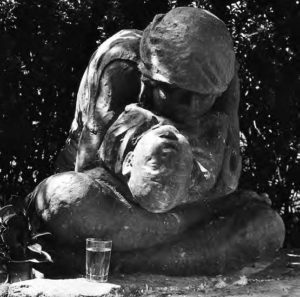
Late Twentieth-Century Uncertainties
Still, Minamata is a city, a small rural city that began to shrink in the 1950s. Even without the mercury poisoning, it would still have had to deal with the problems faced by other rural towns and minor cities in late twentieth century Japan. They struggled to redefine themselves, keep their young people, and reorient their economies as farming, fishing, mining, and smokestack industries became marginalized in an increasingly high-tech, service-oriented economy.
The city government and many of its former critics and enemies among patients and their supporters began a reconciliation movement in the 1990s. Patients spoke at city-sponsored events, and overt discrimination against them declined. Money flowed in from the “construction state” to build more meeting halls than necessary, and a bullet train line and station were built despite opposition from activists. The population has stabilized at around 30,000 (having peaked at 50,000 in 1956), but it is rapidly aging, and Chisso employs only a tenth as many workers as it once did. Whether the city’s attempts at machi-zukuri (town building) or furusatozukuri (rebuilding the old home town) will attract jobs and visitors and help keep young people at home is still unclear. What is certain is that Minamata, in struggling to adapt and survive in a post-industrial age, again mirrors the nation as a whole.
ENGLISH-LANGUAGE RESOURCES
Dower, John W., and John Junkerman, eds. 1985. The Hiroshima Murals: The Art of Iri Maruki and Toshi Maruki. Tokyo: Kōdansha International. On the artists who painted murals of Hiroshima, Nanjing, Okinawa, Auschwitz, and Minamata.
George, Timothy S. 2001. Minamata: Pollution and the Struggle for Democracy in Post-war Japan. Cambridge: Harvard University Asia Center. A survey of the Minamata story arguing that it illustrates the nature of Japan’s postwar democracy as defined through citizen action.
Harada Masazumi. 1972. Minamata Disease. Trans. Tsushima Sachie and Timothy S. George; translation edited by Timothy S. George. Originally published in 1972; the story of Minamata disease to that point, told by the activist doctor who worked most closely with the patients. Ordering information at http://www.soshisha.org/english/book/book_e_frame.htm.
Norie Huddle, Michael Reich, with Nahum Stiskin. 1975. Island of Dreams: Environmental Crisis in Japan. New York: Autumn Press; reprinted Cambridge, Mass.: Schenkman Books, 1987. Includes a chapter on Minamata.
Ishimure Michiko. 1990. Paradise in the Sea of Sorrow: Our Minamata Disease. Trans. Livia Monnet. Kyoto: Yamaguchi Publishing House. Republished in 2003 by Center for Japanese Studies, University of Michigan. A combination of poetic and journalistic styles narrating real events but often changing the names of those involved.
McKean, Margaret A. 1981. Environmental Protest and Citizen Politics in Japan. Berkeley: University of California Press.
Mishima Akio. 1992. Bitter Sea: The Human Cost of Minamata Disease. Trans. Richard L. Gage and Susan B. Murata. Tokyo: Kosei.
Molony, Barbara. 1990. Technology and Investment: The Prewar Japanese Chemical Industry. Cambridge, Mass.: Harvard University Council on East Asian Studies. Detailed study of Chisso (then called Nihon Chisso) before the disease.
Oiwa Keibo, narrated by Ogata Masato. 2001. Rowing the Eternal Sea: The Story of a Minamata Fisherman. Trans. Karen Colligan-Taylor. Lanham, Maryland: Rowman & Littlefield. This autobiography is one of the most appealing and powerfully moving books one could assign on Minamata.
Saitō Hisashi. 2009. Niigata Minamata Disease. Trans. and ed. Aileen M. Smith, Timothy S. George, et al. Niigata: Niigata Nippō Jigyōsha. The Niigata Minamata disease story, by the doctor most closely involved with the patients since the discovery of the disease. Ordering information at http://sites.google.com/site/niigataminamata/.
Smith, W. Eugene, and Aileen M. Smith. 1975. Minamata. New York: Holt, Rinehart and Winston. Final achievement of one of the world’s great photographers; the book that made the world aware of Minamata.
Ui Jun, ed. 1992. Industrial Pollution in Japan. Tokyo: United Nations University Press.
FILMS
John W. Dower and John Junkerman, Hellfire: A Journey from Hiroshima, 1985, sixty minutes. Focuses on the Hiroshima murals by Maruki Iri and Maruki Toshi; also deals with their Minamata work. Available on DVD with Tsuchimoto Noriaki’s Hiroshima no pika, http://firstrunfeatures.com/hiroshimanopika.html.
Minamata: The Victims and Their World, directed by Tsuchimoto Noriaki (Higashi purodakushon), Black and white, 120 minutes, 1971. English version of Minamata: kanjasan to sono sekai. This and the film below are difficult to purchase but are in the film collections of a number of North American universities.
Minamata Disease: A Trilogy, directed by Tsuchimoto Noriaki (Seirinsha), 16mm, color, 1974–75. English version of Igaku to shite no Minamatabyō.
Minamata’s Message to the World, directed by Tsuchimoto Noriaki (Seirinsha/Radio Quebec), 16mm, color, forty-five minutes, 1976. Based on Tsuchimoto’s Minamatabyō: sono 20 nen. Available from Minamata Disease Center Sōshisha (see Websites below).
WEBSITES
Minamata Disease Center Sōshisha, which supports disease victims in their daily lives, serves as a meeting place, operates a museum, publishes a newsletter, and collects documents, at http://www.soshisha.org/english/index_e.htm.
Minamata City includes a section on Minamata disease, http://www.minamatacity.jp/eng/index.htm. Ministry of the Environment’s National Institute for Minamata Disease, at http://www.nimd.go.jp/english/index.html.
Aileen Archive. Information on Minamata photographs by W. Eugene Smith and Aileen M. Smith, at http://www.aileenarchive.or.jp/aileenarchive_en/index.html.
NOTES
1. Nihon chisso hiryō kabushiki kaisha (An outline of Nihon Chisso’s operations.), Nihon chisso jigyō gaiyō (1940), unpaginated.

